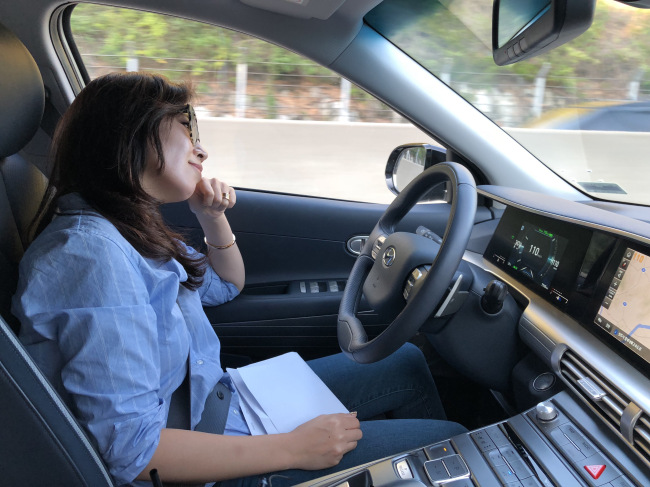[Hydrogen Korea] Car from the future: Nexo excels but faces hydrogen indifference
The Korea Herald takes Nexo for the longest test-drive in the world, from Seoul to Ulsan -- the city of hydrogen
By Cho Chung-unPublished : Sept. 26, 2018 - 15:15
The Korea Herald is publishing a series of articles on South Korea’s latest measures to support the hydrogen economy, the market drive for hydrogen-powered vehicles and the hurdles that stand in the way. This is the fifth installment. -- Ed.
Surrounded by gasoline cars at the Yongin expressway service area, south of Seoul, a midsized sport utility vehicle with a sleek body and grey matte finish caught the eye of motorists.
Looking unfamiliar and futuristic, the new car with its blue license plate constantly attracted the gaze of people, but no one seemed to have any idea what the vehicle was really about.
“Is this the hydrogen car? (I thought) it would be different. … It looks good,” said Park Jeong-beom from Changwon, South Gyeongsang Province, one of those who commented on the Nexo while it was parked en route to Ulsan, South Gyeongsang Province.
Another driver, Hwang Seong-beom from Anseong, Gyeonggi Province, looked slightly surprised as the Nexo’s door handle popped out when a driver with the master key approached the vehicle.
“Wow, this is amazing. But what if it runs out of hydrogen while driving?” he asked.
Yes, The Korea Herald’s mission was all about that.
Nexo is a representation of how Hyundai Motor pictures its future. But the big question is: Can it really be the future of cars?
The carmaker has spent years of research and invested a large sum to develop the fuel cell electric car powered by hydrogen. Unveiled at the Consumer Electronics Show early this year, Nexo can run up to 609 kilometers on a single charge, the longest driving range in the world.
Despite its hydrogen technology, Nexo remains quite unknown in the market. A lack of infrastructure, intense rivalry from supporters of lithium-ion battery cars and public indifference toward hydrogen play a big part.
That’s how The Korea Herald’s two-day journey began -- to better understand Nexo and to test its viability as a vehicle of the future.

From Herald Square in central Seoul, home to The Korea Herald, to Ulsan in South Gyeongsang Province, which bills itself as “the city of hydrogen,” Nexo ran around 360 kilometers for a single trip, the longest media test-drive for the hydrogen vehicle in the world.
Nexo came to us with hydrogen tanks fully charged. The digital dashboard said it could run 539 kilometers. But wait. Not 609 kilometers when fully charged, as certified by the Ministry of Environment?
Hyundai Motor had an explanation. Hydrogen is compressed at 700 bars for Nexo’s tanks and in order to fully charge hydrogen, refueling pressure must by higher than the 700-bar mark, which doesn’t exist in South Korea, according to officials.
For the trip, the maximum distance was no deterrent, as 539 kilometers more than covered the 360 kilometers to Ulsan.
But we then asked, will any other power-consuming system affect the distance of Nexo?
We needed to go to extremes. With full air conditioning, navigation and entertainment content playing simultaneously, Nexo hit the road for five hours on the Gyeongbu Expressway, which connects Seoul and Busan. Ulsan is a half hour away from Busan.
Nexo was nothing like any other Hyundai car -- not even its luxury brand, Genesis.
The carmaker ditched the gearbox -- of course, it does not need it -- and placed electronic transmission buttons instead next to the air conditioning controller. Most of the electronic buttons are aligned on the bridge-type center console, which creates a feeling of a spaceship.
Horizontally wide screens, eco-friendly leather seats and the Krell premium sound system with eight speakers and external amplifier are among the unique features of Nexo -- luxurious when considering its final price of 37 million won ($33,170), after the government subsidy.
Like other electric vehicles, it remains silent even when the start button is pressed, except for a very thin sound coming from the back seat. It is the hydrogen tank opening its valve, according to Hyundai.
To understand the mechanism of how hydrogen vehicles work, think of a simple chemical formula -- H2O. The fuel cell, the heart of the vehicle, combines hydrogen, from compressed gas tanks underneath the passenger seat -- and oxygen absorbed from the grille, to produce power for the electric motor.
It is powered by hydrogen but is, in fact, an electric vehicle that glides, just like ice skating, and speeds up pretty fast, reaching 100 kilometers per hour in 9.5 seconds.
The speed went up smoothly up to 150-160 kilometers per hour, and sealed outer noise quite perfectly.
The highlight of the five-hour drive was the highway drive assist system, which allows drivers to take their hands off the steering wheel. Though it required some courage to trust the machine, the level 2 autonomous-vehicle technology lasted 20 seconds and automatically reduced the speed by sensing the distance of vehicles ahead. Nexo asks for the driver to take the wheel again, and upon sensing that the hands are back on the wheel, the semi-self-driving continues.
This function appears to be a prelude to Hyundai’s autonomous driving on the fuel cell platform, which can produce more electricity than lithium-ion batteries so far. The carmaker has been working with California-based Aurora, to realize full autonomous-driving technology, which consumes a large amount of power to process data, sensors and maneuver.
After five hours, the Nexo reached Ulsan, the industrial city that is home to Hyundai Motor. It still had a remaining driving range of 145 kilometers. No heat was felt from under the hood, where fuel cell stacks and a motor connected by a myriad of cables are installed. And most importantly, no greenhouse gases were emitted all the way.
It may look like a regular car, but the Nexo definitely showed a glimpse into the future of auto technology -- a smart and sustainable one.
However, it seems to be facing bigger obstacles for now: the price and a lack of awareness about hydrogen.
Hyundai has only delivered 251 vehicles between March and August to those who signed contracts on the condition that they would receive a government subsidy, which covers nearly half the price. The starting price is 68.9 million won. The final price is around 37.2 million to 39.7 million won after the state subsidy is reflected, but the government supports some 300 hydrogen enthusiasts on a first-come, first-served basis.
Without the subsidy, many consumers will be reluctant to buy a 70 million won car, particularly considering the inconvenience they are likely to face due to the poor hydrogen infrastructure network. There are 11 refueling stations across the country, but only six are for public use.
The challenge of the hydrogen car is that it should expand its reach to the public. In other words, Nexo should be more affordable.
Park from Changwon agrees.
“I believe there will be more vehicles like this in the future, as our resources (fossil fuel reserves) are running out. I (would get) one just like this one, only if I could afford it,” said Park, as he walked toward his gasoline-fueled vehicle.
By Cho Chung-un (christory@heraldcorp.com)
Staff reporter Lim Jeong-yo contributed to this article. -- Ed.




















![[Today’s K-pop] BTS pop-up event to come to Seoul](http://res.heraldm.com/phpwas/restmb_idxmake.php?idx=642&simg=/content/image/2024/04/17/20240417050734_0.jpg&u=)